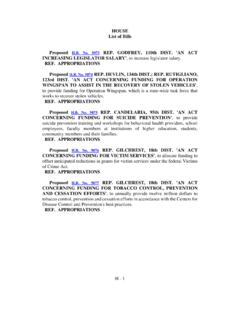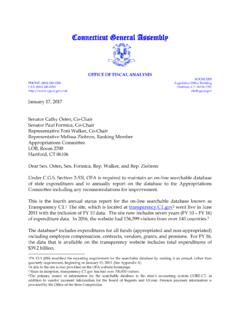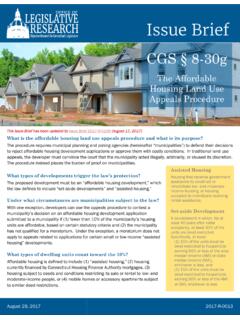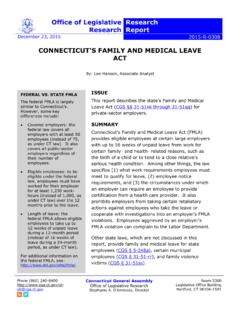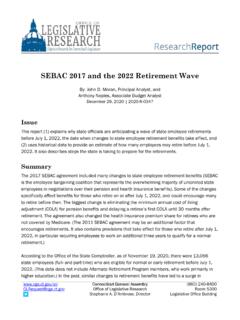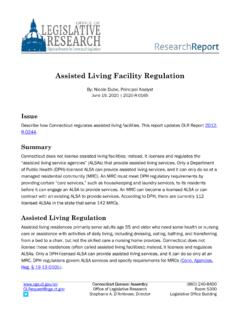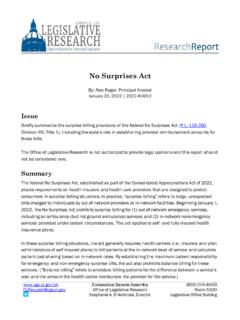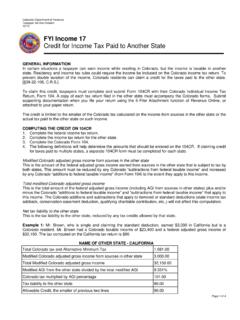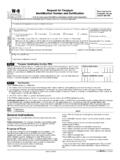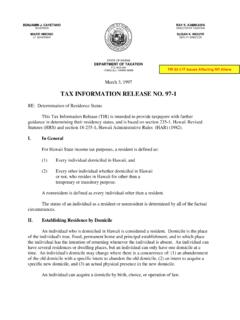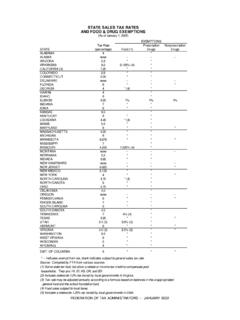Transcription of State Income Tax Benefits for Contributions to 529 Plans ...
1 C o nnecticut General Assembly Office of Legislative Research Stephanie A. D Ambrose, Director (860) 240-8400 Room 5300 Legislative Office Building State Income Tax Benefits for Contributions to 529 Plans and ABLE Accounts By: Heather Poole, Principal Analyst October 6, 2021 | 2021-R-0167 Issue Provide a brief overview of 529 Plans and ABLE accounts and a 50- State survey of State Income tax deductions and credits for Contributions to them. Summary 529 Plans and ABLE accounts (also known as 529A Plans ) are tax-advantaged investment Plans designed to encourage saving for a designated beneficiary s education- or disability-related expenses. With regard to federal taxes, Contributions to these Plans and accounts are made on a post-tax basis, earnings grow tax-deferred, and withdrawals are tax-free if used for qualifying expenses. The State tax treatment of 529 plan and ABLE account earnings and withdrawals is generally the same as the federal treatment, but some states additionally provide State Income tax Benefits for Contributions to encourage participation.
2 Of the 41 states plus the District of Columbia that impose an Income tax, 20 provide a State tax benefit for Contributions to both Plans , 16 provide a benefit only for Contributions to 529 Plans , and six do not provide a benefit for Contributions to either plan. 529 and ABLE Plans Overview Both 529 and ABLE Plans are tax-advantaged savings accounts, but they are used for different purposes. 529 Plans (also known as a qualified tuition Plans ) are used to save for future education costs, such as college tuition and room and board or, in some cases, K-12 tuition expenses. Anyone can open a 529 plan and designate a beneficiary. Federal law does not set annual contribution 2021-R-0167 October 6, 2021 Page 2 of 6 limits for 529 Plans ; instead, states set aggregate contribution limits for their Plans based on the price to attend college and graduate school in the State . For more information on 529 Plans , see An Introduction to 529 Plans from the Securities and Exchange Commission.
3 ABLE accounts (named for the 2014 federal Achieving a Better Life Experience (ABLE) Act which established them) allow individuals to retain assets to offset costs associated with living with a disability (up to certain account limits) without affecting eligibility for means-tested public programs such as supplemental security Income (SSI) and Medicaid. Individuals may open an ABLE account, or one may be opened on their behalf, if they developed their disability before age 26 and either (1) qualify for SSI or Social Security disability Income (SSDI) or (2) have a certification from a licensed physician stating that their disability meets the marked and severe standard set forth in federal law. Account funds may be used to cover qualified disability expenses, which are disability-related expenses that help increase or maintain a person s health, independence, or quality of life ( , housing, transportation, education, and assistive technology costs).
4 Total annual Contributions to an ABLE account by all individuals are generally capped at the federal gift tax exclusion amount ($15,000 per year), though certain employed ABLE account owners may make additional deposits). Aggregate account limits are set by State plan administrators. For more information on ABLE accounts, see the ABLE National Resource Center website (managed by the National Disability Institute). State Tax Benefits for Contributions Of the 41 states plus the District of Columbia that impose an Income tax, 36 provide some kind of tax benefit for Contributions to one or both of these Plans . Most jurisdictions providing a benefit do so for Contributions to both 529 and ABLE Plans (20 jurisdictions), but some (16 jurisdictions, including Connecticut) do so only for 529 plan Contributions . Of the states that offer a benefit, most offer deductions rather than credits.
5 (A tax deduction reduces the amount of a taxpayer s Income that is subject to tax, and a tax credit directly reduces taxes owed.) In states that offer Benefits for Contributions to both types of Plans , the benefit is typically the same value for each plan, with a few exceptions. Table 1 indicates whether each jurisdiction provides a benefit for ABLE account Contributions and 529 plan Contributions and, if it does, the amount of the benefit. The table does not include tax Benefits specific to employer Contributions . Additionally, according to the ABLE National Resource Center, ABLE programs in Hawaii, Idaho, Maine, North Dakota, South Dakota, and Wisconsin are inactive. 2021-R-0167 October 6, 2021 Page 3 of 6 T a ble 1: State Income Tax B enefits for Contributions to 529 Plans or A BLE a ccounts State Deduction or Credit for Contributions Deduction or Credit Amount ABLE 529 Alabama No Yes Maximum deduction of $5,000 per year for individuals or $10,000 per year for joint filers (if both spouses contribute) for Contributions to Alabama 529 Plans Alaska N/A N/A Alaska has no State Income tax Arizona Yes Yes Beginning with the 2021 tax year, maximum deduction of $2,000 for individuals or $4,000 for joint filers per beneficiary, per year for Contributions to any State s Plans (Prior to 2021, ABLE Contributions were not deductible) Arkansas Yes Yes Beginning with the 2021 tax year, maximum deduction of $5,000 per year for individual filers and $10,000 per year for joint filers for Contributions to Arkansas Plans California No No Colorado No Yes For the 2022 tax year (annually adjusted)
6 , maximum deduction of $20,000 for individuals and $30,000 for joint filers per year, per beneficiary for Contributions to Colorado 529 Plans ( Contributions are fully deductible for the 2021 tax year and prior years) Connecticut No Yes Maximum deduction of $5,000 per year for individuals and $10,000 per year for joint filers for Contributions to Connecticut 529 Plans Delaware No No District of Columbia No Yes Maximum deduction of $4,000 per year for individuals and $8,000 per year for joint filers for Contributions to DC 529 Plans Florida N/A N/A Florida has no State Income tax Georgia No Yes Maximum deduction of $4,000 for individuals and $8,000 for joint filers per beneficiary, per year for Contributions to Georgia 529 Plans Hawaii No No Idaho No Yes Maximum deduction of $6,000 per year for individuals and $12,000 per year for joint filers for Contributions to Idaho 529 Plans Illinois Yes Yes Maximum deduction of $10,000 per year for individuals and $20,000 per year for joint filers for Contributions to Illinois 529 and ABLE Plans 2021-R-0167 October 6.
7 2021 Page 4 of 6 Indiana No Yes Maximum $1,000 credit per year for Contributions to an Indiana 529 plan (equal to 20% of Contributions up to $5,000) Iowa Yes Yes For the 2021 tax year (annually adjusted), maximum deduction of $3,474 per contributor, per beneficiary for Contributions to Iowa Plans Kansas Yes Yes Maximum deduction of $3,000 for individuals and $6,000 for joint filers per year, per beneficiary for Contributions to any State s plan Kentucky No No Louisiana No Yes Maximum deduction of $2,400 for individuals and $4,800 for joint filers per beneficiary, per year for Contributions to Louisiana 529 Plans Maine No No Maryland Yes Yes Maximum deduction of $2,500 for individuals and $5,000 for joint filers per beneficiary, per year for Contributions to Maryland Plans Massachusetts No Yes Maximum deduction of $1,000 per year for individuals and $2,000 per year for joint filers for Contributions to Massachusetts 529 Plans Michigan Yes Yes Maximum deduction of $5,000 per year for individuals and $10.
8 000 for joint filers for Contributions to Michigan Plans Minnesota No Yes Maximum deduction of $1,500 per year for individuals and $3,000 for joint filers for Contributions to any State s 529 plan, or Maximum credit of $500 per year (equal to 50% of Contributions ) based on Income level Mississippi Yes Yes Maximum deduction of $10,000 per year for individuals and $20,000 for joint filers for Contributions to a Mississippi 529 plan; Contributions to Mississippi ABLE Plans are fully deductible Missouri Yes Yes Maximum deduction of $8,000 per year for individuals and $16,000 for joint filers for Contributions to a Missouri ABLE plan or any State s 529 plan Montana Yes Yes Maximum deduction of $3,000 per year for individuals and $6,000 for joint filers for Contributions to a Montana ABLE plan or any State s 529 plan Nebraska Yes Yes Maximum deduction of $5,000 per year for individuals and $10,000 for joint filers for Contributions to a Nebraska plan Nevada N/A N/A Nevada does not have a State Income tax New Hampshire N/A N/A New Hampshire does not have a State Income tax 2021-R-0167 October 6, 2021 Page 5 of 6 New Jersey No Yes Beginning with the 2022 tax year, maximum deduction of $10,000 per taxpayer per year for taxpayers with gross incomes of $200.
9 000 or less that contribute to New Jersey s 529 plan ( Contributions made before 2022 tax year are not deductible) New Mexico No Yes Contributions to New Mexico 529 Plans are fully deductible New York No Yes Maximum deduction of $5,000 per year for individuals and $10,000 for joint filers for Contributions to a New York 529 plan North Carolina No No North Dakota No Yes Maximum deduction of $5,000 per year for individuals and $10,000 for joint filers for Contributions to a North Dakota 529 plan Ohio Yes Yes Maximum deduction of $4,000 per beneficiary per year (all filing statuses) for Contributions to an Ohio plan Oklahoma Yes Yes Beginning with the 2021 tax year, maximum deduction of $10,000 per year for individuals and $20,000 for joint filers for Contributions to an Oklahoma 529 or ABLE plan (Prior to the 2021 tax year, only 529 plan Contributions were deductible) Oregon Yes Yes Maximum credit of $150 for individuals and $300 for joint filers per year for Contributions to Oregon Plans .
10 The percentage of Contributions eligible for credit varies based on Income Pennsylvania Yes Yes Maximum deduction of $15,000 per year for individuals and $30,000 for joint filers, per beneficiary, for Contributions to Pennsylvania ABLE Plans or any State s 529 plan Rhode Island No Yes Maximum deduction of $500 per year for individuals and $1,000 per year for joint filers for Contributions to Rhode Island s 529 plan South Carolina Yes Yes Contributions to South Carolina Plans are fully deductible South Dakota N/A N/A South Dakota does not have a State Income tax Tennessee N/A N/A Tennessee does not have a State Income tax Texas N/A N/A Texas does not have a State Income tax Utah Yes Yes Credit equals 5% of Contributions to Utah Plans (For 529 Plans , maximum credit is $102 for individuals and $204 for joint filers per beneficiary for 2020 tax year) Vermont No Yes Maximum credit of $250 for individuals and $500 for joint filers per beneficiary (10% of the first $2,500 or $5,000 contributed) for Contributions to a Vermont 529 plan 2021-R-0167 October 6, 2021 Page 6 of 6 Virginia Y e s Y e s Maximum deduction of $4,000 per account for Contributions to a Virginia 529 plan (no limit for contributors age 70 and above) Maximum deduction of $2,000 per contributor for Contributions to Virginia ABLE Plans Washington N/A N/A Washington does not have a State Income tax West Virginia Yes Yes Contributions to West Virginia Plans are fully deductible Wisconsin Yes Yes For 2021 tax year (annually adjusted), maximum deduction of $3,380 per beneficiary per year ($1,690 for married filing separately or divorced parents)
